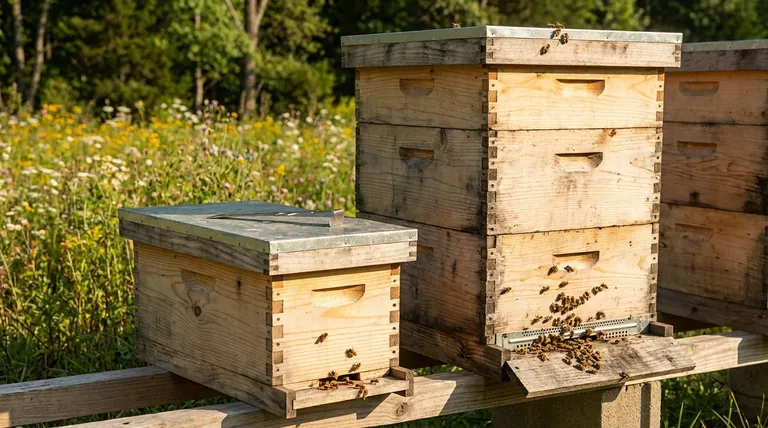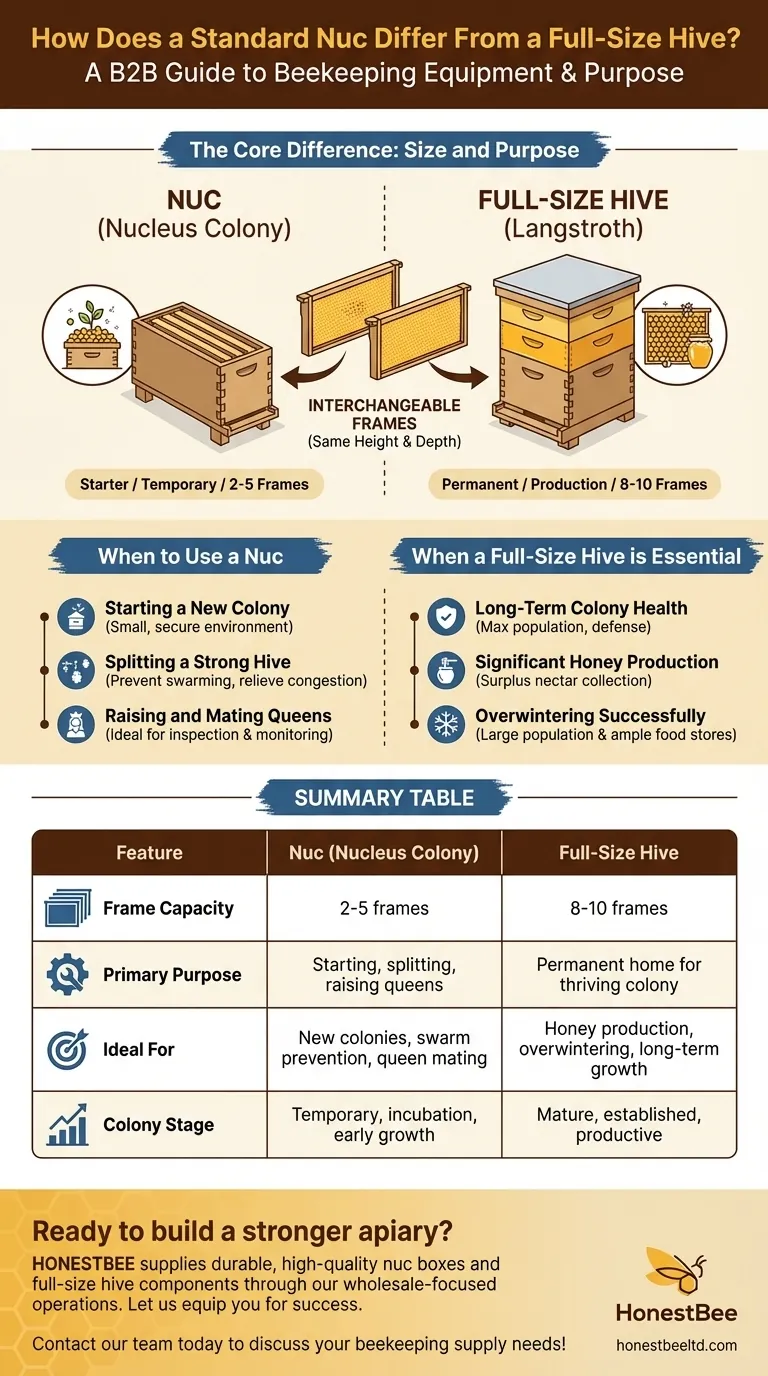At its core, a nuc is a miniature, starter version of a full-size beehive. A standard nuc (nucleus colony) box is designed to hold between two and five frames, whereas a full-size Langstroth hive holds eight to ten. Crucially, a nuc uses the exact same size frames as a full-size hive, simply fewer of them, making it narrower but otherwise compatible.
The fundamental difference isn't just about size; it's about purpose. A nuc is a temporary tool for starting, raising, or splitting a small colony, while a full-size hive is the permanent home required for a colony to thrive, produce honey, and survive the winter.

The Core Difference: Size and Purpose
The distinction between these two pieces of equipment is central to managing the lifecycle of a honey bee colony. One is for incubation and early growth, the other is for mature, established production.
Frame Capacity and Dimensions
A nuc box is essentially a slice of a full hive. It shares the same height and depth as a standard Langstroth hive box, ensuring that the frames are perfectly interchangeable between them.
The only difference is width. This reduced space concentrates the small colony's heat and resources, making it easier for them to manage their environment.
The "Nucleus" Concept
The term "nuc" is short for a nucleus colony. It contains all the essential components of a full hive in miniature: a queen, worker bees, drones, brood (eggs, larvae, and pupae), and food stores (pollen and honey).
This small, self-sufficient unit is the perfect starting point for a new colony.
The Natural Progression
Nearly every colony begins its life in a nuc. Beekeepers use them to nurture a new queen or a small package of bees until the population grows.
Once the bees have filled most of the frames in the nuc, they are transferred—frames and all—into a full-size hive where they have room to expand.
When to Use a Nuc
A nuc is a specialized tool used for specific, temporary tasks that require managing a smaller population of bees.
Starting a New Colony
A nuc provides a small, secure environment for a new package of bees or a newly purchased nucleus colony. The confined space is easier for a small bee population to defend from pests and to keep warm, which is critical for raising brood.
Splitting a Strong Hive
To prevent a powerful colony from swarming, a beekeeper can "split" it by moving a few frames of brood, bees, and the old queen into a nuc. This relieves congestion in the parent hive and creates a new, secondary colony.
Raising and Mating Queens
Nucs are the ideal environment for raising new queens. The smaller population makes it easy for a beekeeper to inspect the frames, locate the queen, and monitor her development and mating success.
When a Full-Size Hive is Essential
While a nuc is for starting, a full-size hive is for establishing. It is the necessary home for any colony intended to be permanent and productive.
Long-Term Colony Health
A full-size hive provides the space a colony needs to reach its maximum population potential. This large workforce is essential for colony health, defense, and resource gathering.
Significant Honey Production
Only a large, thriving colony housed in a full-size hive can collect enough surplus nectar to produce a significant honey harvest for the beekeeper. A nuc colony will use all its resources just to survive and grow.
Overwintering Successfully
A colony's ability to survive the winter depends on two factors: a large population to form a tight cluster for warmth and ample honey stores for food. A nuc fails on both counts; it is simply too small to house a colony with the resources needed to survive a cold winter.
Making the Right Choice for Your Goal
Selecting the right equipment is determined entirely by the task at hand and the current state of your colony.
- If your primary focus is starting a new colony: Always begin with a nuc to provide a safe, manageable environment for the bees to establish themselves.
- If your primary focus is honey production and long-term survival: Your goal is to move your colony from a nuc into a full-size hive as soon as they are strong enough to need the space.
- If your primary focus is swarm prevention or raising queens: A nuc is the essential beekeeping tool for creating splits and managing queen cells effectively.
Understanding the distinct roles of a nuc and a full-size hive is the foundation of successful and proactive colony management.
Summary Table:
| Feature | Nuc (Nucleus Colony) | Full-Size Hive |
|---|---|---|
| Frame Capacity | 2-5 frames | 8-10 frames |
| Primary Purpose | Starting, splitting, or raising queens | Permanent home for a thriving colony |
| Ideal For | New colonies, swarm prevention, queen mating | Honey production, overwintering, long-term growth |
| Colony Stage | Temporary, incubation, and early growth | Mature, established, and productive |
Ready to build a stronger apiary?
Whether you're a commercial apiary scaling up or a distributor stocking for the season, having the right equipment is the first step to success. HONESTBEE supplies durable, high-quality nuc boxes and full-size hive components through our wholesale-focused operations.
Let us equip you for success. Contact our team today to discuss your beekeeping supply needs and get a quote!
Visual Guide

Related Products
- HONESTBEE Advanced Ergonomic Stainless Steel Hive Tool for Beekeeping
- HONESTBEE Professional Long Handled Hive Tool with Precision Cutting Blade
- HONESTBEE Professional Multi-Functional Hive Tool with Ergonomic Wood Handle
- Professional Dual-End Stainless Steel Hive Tool for Beekeeping
- Multi-Function Plier-Style Frame Grip Hive Tool
People Also Ask
- What are the basic tools for beekeeping? Essential Starter Kit for Safe & Successful Hive Management
- What is a hive tool and what are its uses? Master Your Hive Inspections with the Essential Beekeeper's Tool
- How should beekeepers handle bees when using a hive tool? Master Calm, Deliberate Techniques
- Why do hive tools have a hole? Unlock the Secret to Efficient Beekeeping
- Why is it important to compare the progress of different hives? A Beekeeper's Key Diagnostic Tool



















